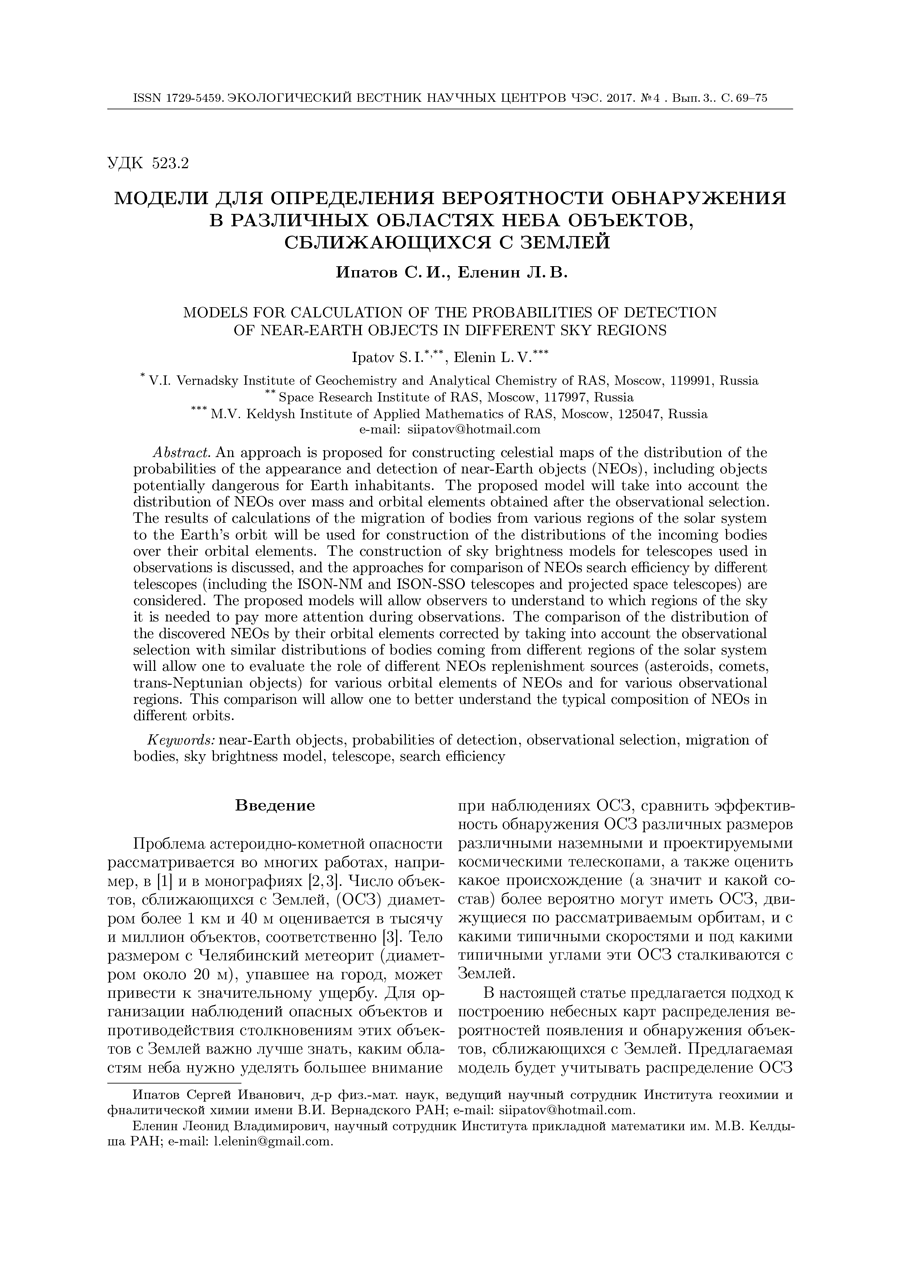Models for calculation of the probabilities of detection of near-Earth objects in different sky regions
UDC
523.2Abstract
An approach is proposed for constructing celestial maps of the distribution of the probabilities of the appearance and detection of near-Earth objects (NEOs), including objects potentially dangerous for Earth inhabitants. The proposed model will take into account the distribution of NEOs over mass and orbital elements obtained after the observational selection. The results of calculations of the migration of bodies from various regions of the solar system to the Earth's orbit will be used for construction of the distributions of the incoming bodies over their orbital elements. The construction of sky brightness models for telescopes used in observations is discussed, and the approaches for comparison of NEOs search efficiency by different telescopes (including the ISON-NM and ISON-SSO telescopes and projected space telescopes) are considered. The proposed models will allow observers to understand to which regions of the sky it is needed to pay more attention during observations. The comparison of the distribution of the discovered NEOs by their orbital elements corrected by taking into account the observational selection with similar distributions of bodies coming from different regions of the solar system will allow one to evaluate the role of different NEOs replenishment sources (asteroids, comets, trans-Neptunian objects) for various orbital elements of NEOs and for various observational regions. This comparison will allow one to better understand the typical composition of NEOs in different orbits.
Keywords:
near-Earth objects, probabilities of detection, observational selection, migration of bodies, sky brightness model, telescope, search efficiencyReferences
- Shustov B.M., Naroenkov S.A., Emel'yanenko V.V., Shugarov A.S. Astronomical aspects of building a system for detecting and monitoring hazardous space objects. Solar System Research, vol. 47, no. 4, pp. 288-295. DOI: 10.1134/S0038094613040199).
- Asteroidno-kometnaja opasnost': vchera, segodnja, zavtra [Asteroid and comet hazard: yesterday, today, tomorrow]. Eds. B.M. Shustov, L.V. Ryhlova, Moscow, FIZMATLIT, 2010, 384 p.
- Handbook of cosmic hazards and planetary defense. Eds. J.N. Pelton, F. Allahdadi. Switzerland: Springer International Publishing, 2015, 1127 p. DOI: 10.1007/978-3-319-03952-7
- Emel'yanenko V.V., Naroenkov S.A. Dynamical features of hazardous near-Earth objects. Astrophysical Bulletin, 2015, vol. 70, no. 3, pp. 342-348. DOI 10.1134/S199034131503013X (Russian version: Emel'yanenko V.V., Naroenkov S.A. Dinamicheskie osobennosti opasnyh okolozemnyh ob'ektov [Dynamical features of hazardous near-Earth objects]. Astrofizicheskij bjulleten' [Astrophysical bulletin], 2015, vol. 70, pp. 243-249).
- Tricarico P. A distributed computing system for near-Earth objects hazard monitoring. Abstracts of the 36th DPS meeting, #32.17. Bulletin of the American Astronomical Society, 2004, vol. 36, p. 1141.
- Tricarico P. An efficient search strategy for near-Earth asteroids. Abstracts of the 38th Lunar and Planetary Science Conference, 2007, no. 1338, p. 2357.
- Tricarico P. Detection efficiency of asteroid surveys. The Astronomical Journal, 2016, vol. 151, article id. 80, 7 pp. DOI: 10.3847/0004-6256/151/3/80
- Ipatov S.I., Kutyrev A., Madsen G.J., Mather J.C., Moseley S.H., Reynolds R.J. Dynamical zodiacal cloud models constrained by high resolution spectroscopy of the zodiacal light. Icarus, 2008, vol. 194, no. 2, pp. 769-788. DOI: 10.1016/j.icarus.2007.11.009. http://arxiv.org/abs/0711.3494
- Bottke W.F. Jr., Morbidelli A., Jedicke R., Petit J.-M., Levison H.F., Michel P., Metcalfe T.S. Debiased orbital and absolute magnitude distribution of the near-Earth objects. Icarus, 2002, vol. 156, pp. 399-433. DOI: 10.1006/icar.2001.6788
- Ipatov S.I., Mather J.C. Migration of trans-Neptunian objects to the terrestrial planets. Earth, Moon, and Planets, 2003, vol. 92, pp. 89-98. DOI: 10.1023/B:MOON.0000031928.45965.7b. http:// www.roe.ac.uk/_jkd/kbo_proc/ipatov.pdf
- Ipatov S.I., Mather J.C. Comet and asteroid hazard to the terrestrial planets. Advances in Space Research, 2004, vol. 33, no 9, pp. 1524-1533. DOI: 10.1016/S0273-1177(03)00451-4. http://arXiv.org/format/astro-ph/0212177
- Ipatov S.I., Mather J.C. Migration of small bodies and dust to near-Earth space. Advances in Space Research, 2006, vol. 37, no. 1, pp. 126-137. DOI: 10.1016/j.asr.2005.05.076. http://arXiv.org/format/astro-ph/0411004
- Ipatov S.I., Mather J.C. Migration of comets to the terrestrial planets. Proc. of the IAU Symposium No. 236 "Near-Earth Objects, Our Celestial Neighbors: Opportunity and Risk". Eds. G.B. Valsecchi and D. Vokrouhlicky, 2007, pp. 55-64. DOI: 10.1017/S1743921307003067. http://arxiv.org/format/astro-ph/060972
- Ipatov S.I., Horne K. Models of sky brightness. Abstracts of the 45th Lunar and Planetary Science Conference, 2014, no. 1390. https://www.hou.usra.edu/meetings/lpsc2014/ pdf/1390.pdf
- Ipatov S.I., Horne K., Alsubai, K., Bramich D., Dominik M., Hundertmark M., Liebig C., Snodgrass C., Street R., Tsapras Y. Simulator for microlens planet surveys. Proceedings of the IAU Symp. No. 293 "Formation, detection, and characterization of extrasolar habitable planets". Ed. N. Haghighipour, Cambridge University Press, 2014, pp. 416-419. DOI: 10.1017/S1743921313013306. http://arxiv.org/abs/1308.6159
Downloads
Issue
Pages
Submitted
Published
How to Cite
Copyright (c) 2017 Ipatov S.I., Elenin L.V.

This work is licensed under a Creative Commons Attribution 4.0 International License.




